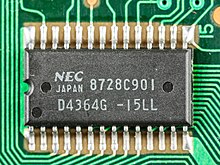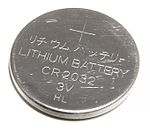| Revision as of 22:01, 26 November 2020 edit奧田95 (talk | contribs)Extended confirmed users2,784 editsNo edit summaryTags: Mobile edit Mobile web edit Advanced mobile edit← Previous edit | Revision as of 07:33, 6 December 2020 edit undoBeland (talk | contribs)Autopatrolled, Administrators237,373 editsm convert special characters (via WP:JWB)Next edit → | ||
| Line 5: | Line 5: | ||
| '''Nonvolatile BIOS memory''' refers to a small ] on ] ]s that is used to store ] settings. It is traditionally called '''CMOS''' RAM because it uses a ], low-power ] ] (such as the ] MC146818 or similar) powered by a small "CMOS" battery when system and standby power is off.<ref name=whatiscmos>{{cite web|url=http://pcsupport.about.com/od/termsc/g/cmos.htm |title=What is CMOS? (CMOS & CMOS Battery Definition) |publisher=] |first=Tim |last=Fisher |accessdate=2 September 2015}}</ref> It is referred to as non-volatile memory or ] because, after the system loses power, it does retain state by virtue of the CMOS battery. The typical NVRAM capacity is 256 ]s.<ref name="100Series" /> | '''Nonvolatile BIOS memory''' refers to a small ] on ] ]s that is used to store ] settings. It is traditionally called '''CMOS''' RAM because it uses a ], low-power ] ] (such as the ] MC146818 or similar) powered by a small "CMOS" battery when system and standby power is off.<ref name=whatiscmos>{{cite web|url=http://pcsupport.about.com/od/termsc/g/cmos.htm |title=What is CMOS? (CMOS & CMOS Battery Definition) |publisher=] |first=Tim |last=Fisher |accessdate=2 September 2015}}</ref> It is referred to as non-volatile memory or ] because, after the system loses power, it does retain state by virtue of the CMOS battery. The typical NVRAM capacity is 256 ]s.<ref name="100Series" /> | ||
| The CMOS RAM and the real-time clock have been integrated as a part of the ] chipset and it may not be a standalone chip on modern motherboards.<ref>https://www.intel.com/Assets/PDF/datasheet/290562.pdf</ref><ref name="100Series">{{cite web|url=http://www.intel.com/content/www/us/en/chipsets/100-series-chipset-datasheet-vol-1.html |title=Intel |
The CMOS RAM and the real-time clock have been integrated as a part of the ] chipset and it may not be a standalone chip on modern motherboards.<ref>https://www.intel.com/Assets/PDF/datasheet/290562.pdf</ref><ref name="100Series">{{cite web|url=http://www.intel.com/content/www/us/en/chipsets/100-series-chipset-datasheet-vol-1.html |title=Intel 100 Series Chipset Family PCH Datasheet| publisher=Intel |date=August 2015 |accessdate=16 April 2016}}</ref> In turn, the southbridge have been integrated into a single ]. | ||
| Today's ] motherboards use ] to store configuration data, but by many ]s' design, the UEFI settings are still lost if the CMOS battery fails<ref>{{Cite web|title=UEFI NVRAM - OSDev Wiki|url=https://wiki.osdev.org/UEFI_NVRAM|access-date=2020-09-11|website=wiki.osdev.org}}</ref>{{unreliable source?|date=November 2020}}. | Today's ] motherboards use ] to store configuration data, but by many ]s' design, the UEFI settings are still lost if the CMOS battery fails<ref>{{Cite web|title=UEFI NVRAM - OSDev Wiki|url=https://wiki.osdev.org/UEFI_NVRAM|access-date=2020-09-11|website=wiki.osdev.org}}</ref>{{unreliable source?|date=November 2020}}. | ||
| Line 15: | Line 15: | ||
| {{ | {{ | ||
| cite web| | cite web| | ||
| title=CMOS Battery on the Intel |
title=CMOS Battery on the Intel NUC | ||
| |url=http://www.intel.com/content/www/us/en/support/boards-and-kits/000006787.html | |url=http://www.intel.com/content/www/us/en/support/boards-and-kits/000006787.html | ||
| |date=24 August 2020 |publisher=Intel | |date=24 August 2020 |publisher=Intel | ||
Revision as of 07:33, 6 December 2020
"CMOS memory" redirects here. For other types of CMOS memory, see Semiconductor memory. "CMOS RAM" redirects here. For other types of CMOS RAM, see Random-access memory.

Nonvolatile BIOS memory refers to a small memory on PC motherboards that is used to store BIOS settings. It is traditionally called CMOS RAM because it uses a volatile, low-power complementary metal-oxide-semiconductor (CMOS) SRAM (such as the Motorola MC146818 or similar) powered by a small "CMOS" battery when system and standby power is off. It is referred to as non-volatile memory or NVRAM because, after the system loses power, it does retain state by virtue of the CMOS battery. The typical NVRAM capacity is 256 bytes.
The CMOS RAM and the real-time clock have been integrated as a part of the southbridge chipset and it may not be a standalone chip on modern motherboards. In turn, the southbridge have been integrated into a single Platform Controller Hub.
Today's UEFI motherboards use NVRAM to store configuration data, but by many OEMs' design, the UEFI settings are still lost if the CMOS battery fails.
CMOS battery

The memory battery (aka motherboard, CMOS, real-time clock (RTC), clock battery) is generally a CR2032 lithium coin cell. This cell battery has an estimated life of 3 years when power supply unit (PSU) is unplugged or when the PSU power switch is turned off.This battery type, contrary to popular belief, is not rechargeable and trying to do so may result in an explosion. Motherboards have circuitry preventing batteries from being charged and discharged when a motherboard is powered on. Other common battery cell types can last significantly longer or shorter periods, such as the smaller CR2016 which will generally last about 40% less time than CR2032. Higher temperatures and longer power-off time will shorten battery cell life. When replacing the battery cell, the system time and CMOS BIOS settings may revert to default values. Unwanted BIOS reset may be avoided by replacing the battery cell with the PSU power switch turned on and plugged into an electric wall socket. On ATX motherboards, the PSU will supply 5V standby power to the motherboard to keep CMOS memory energized while the system is off.
Some computer designs have used non-button cell batteries, such as the cylindrical "1/2 AA" used in the Power Mac G4 as well as some older IBM PC compatibles, or a 3-cell NiCd CMOS battery that looks like a "barrel" (common in Amiga and older IBM PC compatibles), which serves the same purpose. These motherboards often have a four pin straight header, with pin two missing, to connect an external 3.6v battery, such as the Tadiran TL-5242/W, when their soldered on batteries die.
See also
References
- ^ Fisher, Tim. "What is CMOS? (CMOS & CMOS Battery Definition)". About.com. Retrieved 2 September 2015.
- ^ "Intel 100 Series Chipset Family PCH Datasheet". Intel. August 2015. Retrieved 16 April 2016.
- https://www.intel.com/Assets/PDF/datasheet/290562.pdf
- "UEFI NVRAM - OSDev Wiki". wiki.osdev.org. Retrieved 2020-09-11.
- Ask a question » Replacing the battery of your motherboard (CMOS battery)
- "CMOS Battery on the Intel NUC". Intel. 24 August 2020.
External links
- Definition of CMOS & CMOS Batteries
- CMOS memory map (for Bochs PC emulator)
- CMOS rechargeable Battery 3V Lithium, with cable
- How to replace dead CMOS battery and configure BIOS settings (video).
- Tutorial: How to replace the CMOS battery in your laptop
- How to replace the CMOS battery